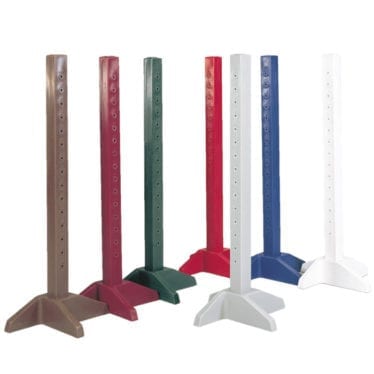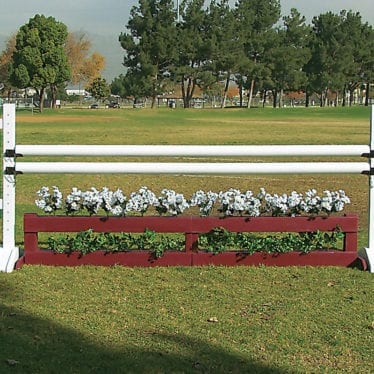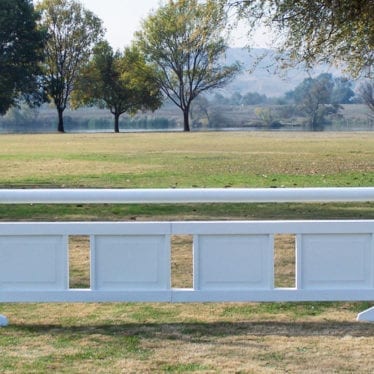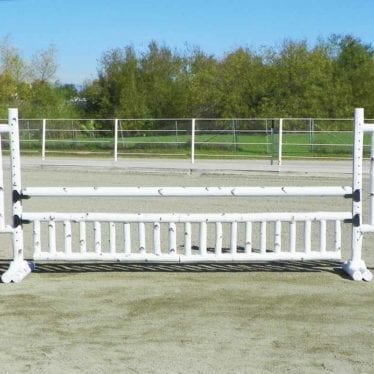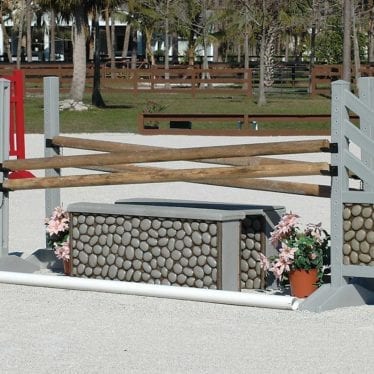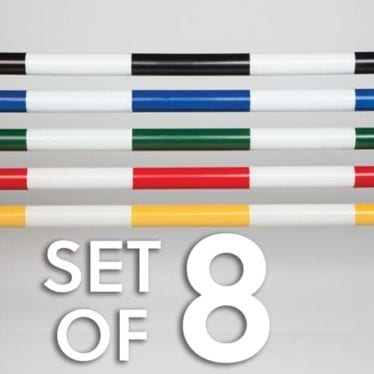Horse jumps usually range anywhere from 2’6” to 5’ tall, depending on the level of competition. The typical starting height in North American events is 2’7”, but the highest level of performance happens in Grand Prix competitions. High horse jumps in Grand Prix competitions can be as tall as 5’2” or even 6’7”. As a beginner, you should not attempt jumps of this height.
Horse Jumps
Showing 1–48 of 163 results
Horse Jump Products
-
Sale!
Quick Cavaletti Pairs
Original price was: $123.95.$111.56Current price is: $111.56.Sold in pairs
Free shipping over $150 >
-
Sale!
Burlingham Sports Schooling Standards (Pr)
Price range: $359.96 through $530.06Free Shipping in the contiguous U.S.
-
Sale!
Jump Blocks
Original price was: $125.00.$112.50Current price is: $112.50.Sold in pairs
Free Shipping in the contiguous U.S.
-
Sale!
Classic Training Jump Standards (Pr)
Original price was: $584.95.$526.46Current price is: $526.46.Free Shipping in the contiguous U.S.
-
Sale!
8′ Solid White Perfect Poles
Price range: $688.50 through $2,065.50Sets of 4, 8, 12
Free Shipping in the contiguous U.S.
-
Sale!
1/2 Striped 1/2 Solid Perfect Poles (Set of 8)
Price range: $1,695.60 through $1,813.5010 and 12 ft long
Free shipping in the contiguous U.S.
-
Sale!
Cavaletti
Original price was: $119.00.$107.10Current price is: $107.10.Sold in pairs
Free Shipping in the contiguous U.S.
-
Sale!
1/2 Striped 1/2 Solid Perfect Poles (Set of 12)
Price range: $2,178.00 through $2,418.3010 and 12 ft long
Free Shipping in the contiguous U.S.
-
Sale!
1/2 Striped 1/2 Solid Perfect Poles (Set of 16)
Price range: $2,821.50 through $3,147.3010 and 12 ft long
Free Shipping in the contiguous U.S.
-
Sale!
Burlingham Sports Jump Flower Boxes
Price range: $186.26 through $353.66Free Shipping in the contiguous U.S.
-
Sale!
Metal Jump Cups with Pin & Chain (Pr)
Original price was: $34.95.$31.46Current price is: $31.46.Free shipping in the contiguous US
-
Sale!
Brush Box
Price range: $455.36 through $548.96Free Shipping in the contiguous U.S.
-
Sale!
Solid Color Picket Gate
Original price was: $624.95.$562.46Current price is: $562.46.Free Shipping in the contiguous U.S.
-
Sale!
Cavaletti Riser Blocks
Price range: $246.56 through $353.66Sets of 12 or 8
Free Shipping in the contiguous U.S.
-
Sale!
Li’l Stacker Cavaletti Blocks
Original price was: $74.95.$67.46Current price is: $67.46.Sold in sets of 4
Free shipping over $150 >
-
Sale!
Quick Cavaletti Package
Original price was: $1,099.00.$989.10Current price is: $989.10.4 pr Cavaletti & 4 Poles
Free Shipping in the contiguous U.S.
-
Sale!
Flower Strips
Price range: $191.66 through $237.56Free Shipping in the contiguous U.S.
-
Sale!
Stone Stack
Price range: $359.96 through $494.06Free Shipping in the contiguous U.S.
-
Sale!
Turf Triangle Flower Box
Price range: $455.36 through $647.06Free Shipping in the contiguous U.S.
-
Sale!
Flower Stairs
Price range: $464.36 through $730.76Free Shipping in the contiguous U.S.
-
Sale!
Slat Wood Wall
Original price was: $550.95.$495.86Current price is: $495.86.Free Shipping in the contiguous U.S.
-
Sale!
Closed Picket Solid Color Gate
Original price was: $624.95.$562.46Current price is: $562.46.Free Shipping in the contiguous U.S.
-
Sale!
Two Panel Solid Color Gate
Original price was: $624.95.$562.46Current price is: $562.46.Free Shipping in the contiguous U.S.
-
Sale!
Four Panel Solid Color Gate
Original price was: $624.95.$562.46Current price is: $562.46.Free Shipping in the contiguous U.S.
-
Sale!
Burlingham Sports Birch Gate
Original price was: $721.95.$649.76Current price is: $649.76.Free Shipping in the contiguous U.S.
-
Sale!
Picket Fence Wall
Original price was: $797.95.$718.16Current price is: $718.16.Free Shipping in the contiguous U.S.
-
Sale!
Closed Picket and Diamond Gate
Original price was: $838.95.$755.06Current price is: $755.06.Free Shipping in the contiguous U.S.
-
Sale!
Two Panel Two Tone Gate
Original price was: $838.95.$755.06Current price is: $755.06.Free Shipping in the contiguous U.S.
-
Sale!
Four Panel Two Tone Gate
Original price was: $838.95.$755.06Current price is: $755.06.Free Shipping in the contiguous U.S.
-
Sale!
Red Brick Wall
Price range: $792.86 through $930.56Free Shipping in the contiguous U.S.
-
Sale!
Stone Wall
Price range: $792.86 through $930.56Free Shipping in the contiguous U.S.
-
Sale!
Travertine Wall
Price range: $792.86 through $930.56Free Shipping in the contiguous U.S.
-
Sale!
Boxwood Hedge
Original price was: $935.95.$842.36Current price is: $842.36.Free Shipping in the contiguous U.S.
-
Sale!
Stone Culvert Wall
Price range: $791.06 through $933.26Free Shipping in the contiguous U.S.
-
Sale!
Red Brick Gate
Original price was: $963.95.$867.56Current price is: $867.56.Free Shipping in the contiguous U.S.
-
Sale!
Stone Gate
Original price was: $963.95.$867.56Current price is: $867.56.Free Shipping in the contiguous U.S.
-
Sale!
Travertine Rock Gate
Original price was: $963.95.$867.56Current price is: $867.56.Free Shipping in the contiguous U.S.
-
Sale!
Timber Jump
Price range: $403.16 through $1,349.96Free Shipping in the contiguous U.S.
-
Sale!
Log Jump Fill
Price range: $942.26 through $1,313.96Free Shipping in the contiguous U.S.
-
Sale!
Burlingham Sports Roll Top
Price range: $1,093.46 through $1,159.16Free Shipping in the contiguous U.S.
-
Sale!
Cross Country Adjustable Log
Price range: $1,041.26 through $1,513.76Free Shipping in the contiguous U.S.
-
Sale!
Skinny Slant Training Jump Standards (Pr)
Original price was: $554.95.$499.46Current price is: $499.46.Free Shipping in the contiguous U.S.
-
Sale!
Striped Jump Poles (Set of 8)
Price range: $1,695.60 through $1,813.5010 and 12 ft long
Free shipping in the contiguous U.S.
-
Sale!
Striped Jump Poles (Set of 12)
Price range: $2,178.00 through $2,418.3010 and 12 ft long
Free Shipping in the contiguous U.S.
-
Sale!
Striped Jump Poles (Set of 16)
Price range: $2,821.50 through $3,147.3010 and 12 ft long
Free Shipping in the contiguous U.S.
-
Sale!
Solid Color Jump Poles (Set of 8)
Price range: $1,515.60 through $1,727.1010 and 12 ft long
Free shipping in the contiguous U.S.
-
Sale!
Solid Color Jump Poles (Set of 12)
Price range: $2,069.10 through $2,365.2010 and 12 ft long
Free Shipping in the contiguous U.S.
-
Sale!
Solid Color Jump Poles (Set of 16)
Price range: $2,605.50 through $2,974.5010 and 12 ft long
Free Shipping in the contiguous U.S.
Premier Equestrian is the leading destination for horse jumps and horse jump products. From decorative horse jump standards & fillers to show jump poles & Cavaletti, we have everything you need to make your next event one to remember. Create a world-class course with cross-country jumps, standards, brush boxes, and jump accessories from Premier. Our wide variety of horse jumps is built to fit the theme and design of your arena, whatever that may be. Each of our horse jump products is constructed with materials that are built to last with your horse’s safety in mind, proudly made in the USA. Mix, match, and customize full horse jumps. Buy today and experience the best quality show jumps on the market.
Horse Jumps FAQs
How many horse jumps should I set up for my course?
Most horse show jump courses include 8 to 16 horse jumps. For schooling purposes, you can use fewer jumps and jump fences multiple times. Horse jump courses include a variety of verticals, spreads or oxers, and combinations depending on the level and style.
A hunter or equitation course typically includes two to three single fences, and two to three longer lines to showcase smoothness, grace, and style. Higher levels of equitation will include more technical questions for the rider.
A show jumping course will have a variety of 8–12 single and combination fences that require the horse and rider to navigate quickly without faults. If the jumper class includes a jump-off, the course will consist of 5-8 jumps to be ridden as efficiently as possible with the fewest faults.
https://youtu.be/4RD-cwPbB7Y?si=QJIfBX4-EtJm-AcS
Watch top show jump rider Todd Minikus explain different horse jump elements and strategies as he builds, walks and rides a course.
Are there different horse jumps for beginners?
Learning to ride over jumps should be gradual. A beginning rider should learn on an experienced horse, and a green horse should be taught by an experienced rider. Ground poles and cavaletti are a great way to learn skills like steering the horse straight to a target, training your eyes, and working on your balance and position when the horse adjusts the length and height of steps. For horses, these are excellent for learning footwork and improving strength and balance.
Ground pole and cavaletti patterns are endlessly available online. Start with walking and trotting over single poles laid around the arena. Build up to circles, serpentines, angles, and lines of poles set to specific distances between each other.
Cross bars, or cross rails, are an ideal jump for beginners because the lowest point is the center. You can build a crossbar using cavaletti or jump standards with jump cups.
Most horse jump standards include pinholes that can fit a horse jump pole between ground level and five feet tall. For example, Premier Equestrian’s Square Panel Jump Standards can move a jumping pole between 1’6” and 4’9” high. These standards are acceptable for practice and competitive settings for beginners. Anything above this height will only be used by highly experienced competitors.
What do I need to start show jumping?
For starters, you’ll want to get a great instructor and the proper riding equipment. If you want to create your arena complete with horse jumps and necessary training equipment, Premier Equestrian has everything you need to create a world-class facility. A simple set of cavaletti or jump blocks, a set of poles, and schooling standards will get you off to a great start.
What are good horse jumps to train with?
There is a variety of high-quality horse jumping equipment to work with. Jumps for horses come in many materials, colors, dimensions, and features, depending on the application. Whatever the application is, Premier Equestrian provides horse jump items, including standards, fillers, flower boxes, gates, cavaletti blocks, and more. Our show jumps are manufactured from safe and durable materials to withstand the rigors or training and time.
What is the difference between dressage and show jumping?
The most obvious difference is that dressage is all done without obstacles. Dressage focuses more on the precision of movements inside a dressage arena with dressage letters. Horse and rider develop and demonstrate specific, progressive skills at each level during a dressage test, from introductory to Grand Prix.
There are different styles within horse jumping, like hunters, equitation, derby, cross country, and show jumping. Each has its own style, rules, and challenges. Jumping equipment can be very specific within each jumping style. Hunters are judged by the horse’s form, style, and smoothness over fences. Cross country utilizes natural jumps, like logs, water, and ditches. Show jumping usually has airy, colorful jumps, and riders navigate a jump course with the fewest faults and fastest time.
Eventing is the equivalent of a triathlon. The horse and rider combination competes in dressage, cross country, and show jumping, all in one competition.


